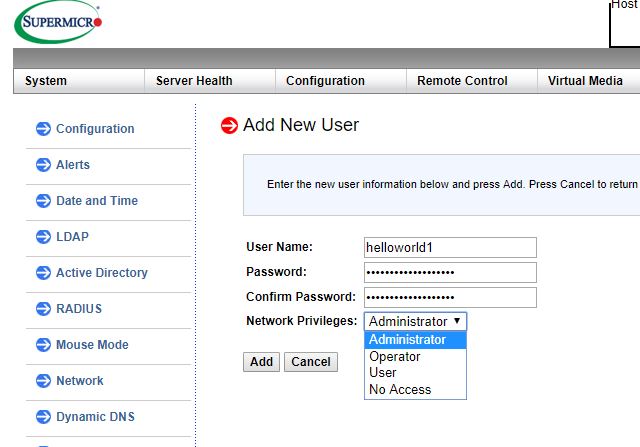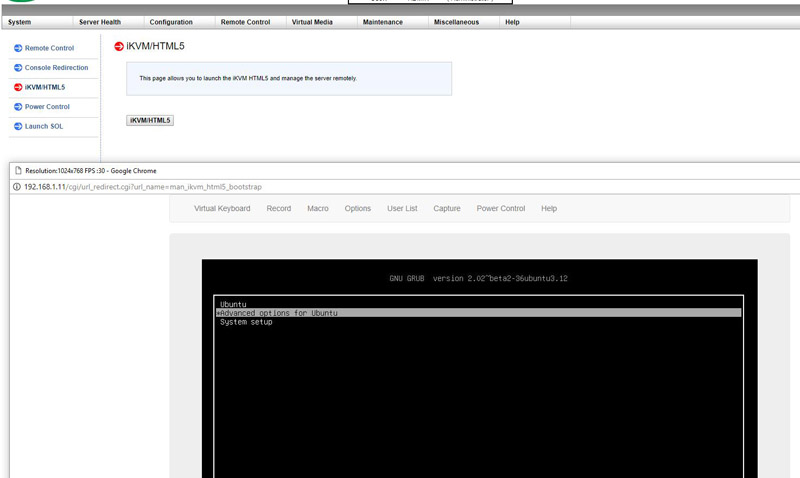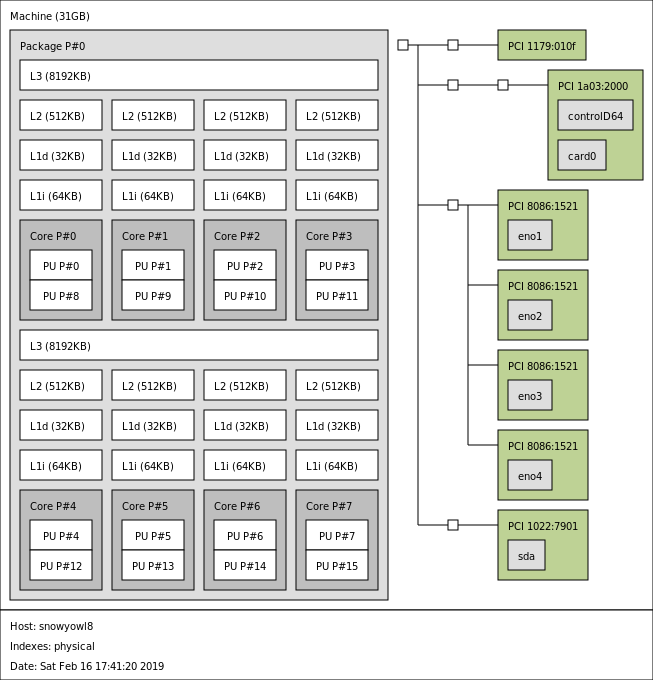Supermicro M11SDV-8C-LN4F Management Overview
These days, out of band management is a standard feature on servers. Supermicro offers an industry standard solution for traditional management, including a WebGUI. This is based on the ASPEED AST2500 solution, a leader in the BMC field. The company is also supporting the Redfish management standard. On this motherboard, we see similar features as we would across the Supermicro X11/H11 ranges. That means whether you are using an embedded Intel motherboard or a 4U EPYC storage server, you will have a similar look and feel to the management experience.

In the latest generation of Supermicro IPMI is an HTML5 iKVM. One no longer needs to use a Java console to get remote KVM access to their server.

Currently, Supermicro allows users to utilize Serial-over-LAN, Java or HTML5 consoles from before a system is turned on, all the way into the OS. Other vendors such as HPE, Dell EMC, and Lenovo charge an additional license upgrade for this capability (among others with their higher license levels.) That is an extremely popular feature. One can also perform BIOS updates using the Web GUI but that feature does require a relatively low-cost license (around $20 street price.) That is a feature we wish Supermicro would include with their systems across product lines.
This pricing differential for a serviceable iKVM functionality is a big deal in this segment. Adding a $200 license to a server can add 10% or more in the embedded platform costs. Supermicro’s iKVM feature is extremely popular due to its inclusion with the server.
Supermicro M11SDV-8C-LN4F Topology
One area that we are keenly aware of today, and will be increasingly so with future multi-chip packages, is system topology.

The AMD EPYC 3251 we are testing is a single die part. Higher-end AMD EPYC 3000 SKUs are dual-die parts where Infinity Fabric bridges the two. PCIe topology is relatively simple here, but that may not be the case for higher-end CPU SKUs.
Next, we are going to take a look at our Supermicro M11SDV-8C-LN4F AMD EPYC 3251 benchmarks, we are then going to focus on power consumption then conclude with our final words on the processors.




Thanks for the informative review, Patrick. This board seems rather MPD to me. Four DIMMs, four SATA, four gigE. It’s not a storage machine: needs more SATA; it’s not much of a router: needs more gigE; it’s not great as a VM host: 128GB DIMMs are frightfully expensive. And any of these applications would benefit from 10gigE.
Just a guy: I would guess this board is just a beginning in a set of boards from Supermicro build around this processor series.
I would totally be in in mATX with dual NVME and 8 Sata ports. Something like this board here:
https://www.supermicro.com/products/motherboard/X11/X11SCH-LN4F.cfm
I’d prefer a single 10GbE SFP+ to quad GbE these days. The limited SATA isn’t concerning to me, it would be easy enough to add an HBA if one really wanted lots of disks.
This would be a good upgrade from my C2558 if it had SFP+
Is there any idea of pricing on these parts? I’m checking our typical SuperMicro supplier here and these parts aren’t even listed yet.
@Bob these parts seem to have the same naming scheme as their Xeon D counterparts, so I would expect a TP4F suffix to have 10Gbit on board as well as (hopefully) some F variants for lower budget embedded appliances. The CPU performance/Watt is perfectly aligned with our edge caching use cases, so I’m eagerly awaiting parts and variants to be available.
https://www.supermicro.com/Aplus/motherboard/Embedded/EPYC3000/
Weirdly they all say they have up to 8 SATA and 10GBase-T
#David
ive just bourght a M11SDV-8C+LN4F from poland and awaiting its arival. I gave 440 euro + shipping for it, to denmark
#Brian
Where did you buy that M11SDV-8C+LN4F?
Hello,
Do you think that this motherboard will fit into the CSE-721TQ-250B chassis? This motherboard has the same dimensions as the supported Xeon boards, and the compact mini-tower chassis would be more useful (and quiet!).
It will, but I would suggest getting the -8C+- version as in the 721TQ you will need an active CPU cooler.
Did the RAM operate at 2666 Mhz? Page 16 of the manual (https://www.supermicro.com/manuals/motherboard/EPYC3000/MNL-2172.pdf) states “When the motherboard is fully populated with 4 modules of single rank DDR4 RDIMM, the memory will operate at speed of 2133MHz”. It gives other cases where RAM speed is diminished, to the point where I’m not sure what configuration of ECC DIMMs should be used to get full 2666 MHz memory speed when using all 4 DIMM slots.
Any ideas?
Alex, we always do performance testing at full speed RAM.
Patrick, yes I saw you used 2666 MHz DIMMs. My point was that the motherboard manual implies that the board can only use RAM at a maximum of 2133 MHz when all 4 DIMM slots are used (see the section I quoted in previous comment). Am I reading it wrong? Were you able to verify the RAM speed?
MNL-2172.pdf (page 16)
“When the motherboard is fully populated with 4 modules of single rank DDR4 RDIMM, the memory will operate at speed of 2133MHz.”
I’m not sure why you guys care about RAM speed so much. It’s standard that most servers, even the E5’s and big EPYC will downclock when fully populated. That’s normal. You can always manually set RAM speed. Easy. It’s working in the boards we’ve deployed and its what you’d always do if you cared about RAM speed. Some companies have their autotuning defaults to keep speed the same and give it fancy names. I don’t see what’s different with this one.
€700+ for the board.
Yikes. According o the domain name servethehome, this is hardly appropriate product.
How many homes can afford that for just a MoBo + CPU ?
For a budget solution, one might be better of with consume grade stuff, downclocked CPU and ECC compatible board…
Brane – I think many here can since they are IT professionals. Just as a FYI – over the last 10+ years STH has become the largest dedicated server review site in the world and we scale to the large multi-system servers.
Feel free to check out the history here: https://www.servethehome.com/sth-turns-10/
Patrick Kennedy:
Fine. But it still caries hefty pricetag for what it is…
Epycs are better binned than off-the-shelf stuff, I understand that.
ECC certification is wrth af few €, too since it already is working in all chips, so it is only the matter of official stamp and perhaps one testing step more during production ( if even that).
So, what is left on the board that is worth those extra €300-400 ?
For us not-exactly profeesionals it seems better to look for off-the-shelf stuff.
R7 1700 is cheap these days ( not much more than €100!) and undeclocked should churn much more than Epyc3000. On one elcheapo uATX board should work just fine.
If I opt for ECC RAM, I’d have to narrow my board choices and use unbuffered ECC, but that’s OK for my useage.
Or perhaps Asus, Asroc or Gigabyte might decide one of these days to dip their toes in these waters…
If the board does not meet your needs, and that is a realization after reading the review, then I think that is a success on our end. Our goal is to present all of the features so people can make decisions. For some, the embedded part makes a ton of sense. For others, it does not. That is the same with any platform and we just want to ensure people have access to enough information to make that decision.
Hi Patrick,
I noticed the X10SDV-TLN4F motherboard (for the XEON D-1541) has x6 SATA3 ports, but this one only has x4. What would be the recommended adapter in order to make use of additional SSDs, as the CSE-721TQ-250B chassis has space for an additional x2 drives?
This looks very interesting, however I see that vs Xeon-D this is not officially supported by VMWare, I found some comments around the web that it had some issues and some updates fixed them, but still is not clear to me how stable it could be. I primary will use it as a home lab server so I can afford a non-official support, however a partially support is not an option, anyone else had the chance to test this platform with a VMware environment (vcsa + nsx + vsan)?
Thanks!
Any thoughts on what the format of the heat sink is? What can I replace it with?
What is factored in when measuring the Power Consumption of these boards ?
Is it just the CPU ?
Or is it the entire configuration ?
If so what Config is it ? CPU+Board+2xRam+1 Drive ?
Entire config. You got it right.
Hi Patrick,
Do you think we can replaced the heatsink with corsair hydro series H60/75?
Hey Patrick, do you intend to review the asrock Epyc platform as well (EPYC3251D4I-2T)?
The 2 boards are interesting, because they come with 2 10GBe, as well as 6 Sata ports by default, unlike the supermicro boards. It would be nice to see how that affects power consumption.
Also do you think there will be ATX Boards with Epyc 3000 Processors in the near future ? Because cutting down their PCIe lanes with the mini-itx design realy sucks.
Some information about idle power use to something like me who uses the platform in residential setting where the system is running 24/7, workload is bursty and idle power use is very important.
With the following configuration I’m getting 22.3W at idle.
M11SDV-8C+-LN4F with EPYC 3251.
Stock fan replaced with Revoltec RL036 (mostly due to noise reduction, but likely it helps power use too).
64GB DDR4-2400 RAM (2x32GB HMA84GR7MFR4N-UH)
WD SN750 1TB NVME SSD
Only single gigabit network cable is connected. BMC is left unconnected.
PSU is 120W 12V power brick (Chieftec CDP-120ITX).
VGA is disabled via jumper (saves 1W)
“powertop –auto-tune” has been run (saves 0.2W if VGA is enabled, 1.1W if VGA is disabled)
The measurement has been made on console login screen of stock Debian 11 that had powertop installed. The power meter is not calibrated.